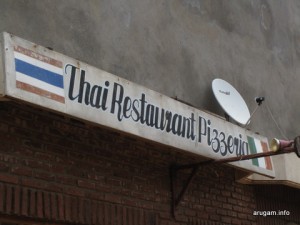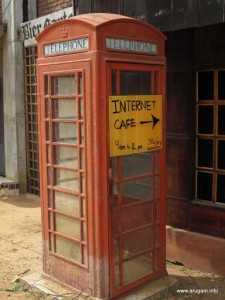
| Sri Lanka – ein Jahr nach dem Tsunami |
|
|
Sri Lanka
Glaube, Liebe,A?A?Hoffnung
Von Volker KlinkmA?ller und Martin H. Petrich |

21.A?NovemberA?2005A?Wer in diesen Wochen zum Urlaub nach Sri Lanka fliegt, wird A?berrascht sein. Fast ein Jahr nach der Tsunami-Katastrophe vom 26. Dezember ist die touristische Infrastruktur in den meisten Regionen weitgehend wiederhergestellt.

Vielerorts sogar mit hA?herwertigen UnterkA?nften und deshalb – wider Erwarten – auch nicht unbedingt preiswerter. Die ersten Pauschaltouristen sind in die groAYen Strandhotels der KA?stenregion zurA?ckgekehrt. Und A?berall lassen sich die AuslA?nder wieder mit den begehrten, fA?r die Insel typischen Ayurveda-Kuren verwA?hnen. Auch der Indische Ozean zeigt sich mit sauberen SandstrA?nden, glasklaren Wellen und fischreichen Korallenriffen von seiner besten Seite.
 |
Schock und Schmerz der Naturkatastrophe indes sitzen natA?rlich tief. Mancherorts zieht sich – mit Ruinen, Schutt, Baumwurzeln oder den letzten Schiffswracks – noch ein GA?rtel der ZerstA?rung an der KA?ste entlang, wA?hrend es die Einheimischen immer wieder dazu drA?ngt, von ihren Verlusten, seien es geliebte Verwandte oder das Dach A?ber dem Kopf, zu berichten. Doch auch sie kA?nnen schon wieder lA?cheln, zeigen sich stets als freundlich und A?beraus bemA?ht. Vielleicht, um sich auf ihre Weise fA?r die SolidaritA?t der zurA?ckkehrenden Besucher zu bedanken.
Das Landesinnere Sri Lankas – mit all seinen kulturhistorischen SehenswA?rdigkeiten und faszinierenden Nationalparks – war in keiner Weise betroffen. In den KA?stengebieten zeigt sich die Lage wie folgt:
Die WestkA?ste
Colombo, Mount Lavinia, Negombo
 |
| Nur noch selten erinnern an den StrA?nden Wracks und TrA?mmer, wie hier in Tangalla, an die Katastrophe |
Colombo war, wie auch der nA?rdlich gelegene Badeort Negombo, kaum vom Tsunami betroffen. Unmittelbar am Strand der Hauptstadt findet sich nach wie vor das rund dreiAYig Jahre alte, auf der Welt einzigartige Seafood-Restaurant a?zBeach Wadiyaa??, das zwar WasserschA?den erlitten hat, aber exakt in seiner bewuAYt schlichten Form wiederhergestellt worden ist.
Im sA?dlich benachbarten, traditionellen Badeort Mount Lavinia haben die Flutwellen zwar einige SchA?den angerichtet, doch hatten alle touristischen Betriebe – bis auf ein einziges kleines Strandrestaurant – schon wenige Wochen nach dem Tsunami wieder geA?ffnet. Auch das legendA?re Kolonialhotel a?zMount Laviniaa?? thront in altem Glanz trotzig auf seinem Felsvorsprung in der tosenden Brandung.
Bentota, Beruwala und Kosgoda
 |
| Mancherorts sind die Hotels jetzt besser – und teurer – als vor der Flutwelle |
Im Vergleich zur SA?d- und OstkA?ste hat es im Westen Sri Lankas nur relativ wenige Tsunami-Tote gegeben. Zumal der GroAYteil der Region vorgewarnt werden konnte. Bis hinunter nach Galle sind fast alle Hotels, Pensionen und Restaurants lA?ngst zum Normalbetrieb zurA?ckgekehrt.
Die groAYen, vor allem am traumhaft schA?nen Palmenstrand von Bentota konzentrierten Pauschalhotels haben ihre Gartenanlagen weitgehend entsalzen kA?nnen. Die Beseitigung der Tsunami-SchA?den haben sie zumeist fA?r vielversprechende Updates und Upgrades ihrer Zimmer oder Suiten genutzt, was zum Teil sogar schon mit Belegungsquoten bis zu siebzig Prozent belohnt wird.
 |
| Trotz einem immer freundlichen LA?cheln – der Tsunami-Schock sitzt bei den Einwohnern noch tief |
In Kalutara A?berzeugt das Hotel a?zKani Lanka Resort & Spaa??, das erst 48 Stunden vor dem Tsunami erA?ffnet und schwer verwA?stet worden war, als neues, innovatives Designer-Hotel. Noch nicht wieder buchbar ist das beliebte a?zTritona??- Hotel in Ahungalla, dessen Reparatur mit einer attraktiven Neugestaltung verbunden wird.
Schwere ZerstA?rungen sind vor allem noch in der Region Beruwala und Kosgoda zu sehen. Die KA?stenstraAYe, die nun vielerorts mit steinernen FlutschutzwA?llen versehen wurde, bietet neuerdings, durch die weitgehend verschwundene Bebauung der FischerhA?tten und die noch umstrittene 100-Meter-Regelung der Nichtbebauung, oft einen bestechend freien Ausblick auf das Meer.
Vereinzelt finden sich noch Schiffswracks, die aber nur aus VersicherungsgrA?nden noch nicht geborgen wurden. Alle frA?heren Touristenattraktionen sind intakt oder haben – wie die a?zTurtle Hatcheriesa?? – einen Neuanfang gemacht. Sie brauchen dringend mehr Besucher, denn ohne die Eintrittsgelder fehlen die Mittel, um die SchildkrA?teneier vor dem Marktverkauf oder dem Verzehr zu retten. Auf den groAYen Lagunen werden wie frA?her reizvolle BootsausflA?ge in das Landesinnere angeboten.
Die SA?dkA?ste
Hikkaduwa
A?berraschende 95 Prozent der frA?heren touristischen Infrastruktur des beliebten, von der KA?stenstraAYe zerschnittenen Urlaubsorts sind wiederhergestellt. Bis auf das Hotel a?zHikkaduwa Beacha?? am Ortseingang haben alle UnterkA?nfte und Gastronomiebetriebe lA?ngst wieder geA?ffnet. Die vorgelagerten Korallenriffe haben durch den Tsunami keinerlei Schaden erlitten. In der Stadt streifen A?berraschend viele SolidaritA?tstouristen umher.
 |
| Schulalltag auf Sri Lanka |
Drei Waggons des berA?hmt-berA?chtigten Eisenbahnzuges, der kurz vor Hikkaduwa in den Flutwellen umgekippt war, was ungeheuer vielen Menschen das Leben gekostet hat, sind am UnglA?cksort belassen worden und sollen Bestandteil eines Tsunami-Mahnmals werden. Schon jetzt wird dieser Ort als schaurige SehenswA?rdigkeit von Scharen in- und auslA?ndischer Touristen heimgesucht. Genau wie beim an Land gespA?lten Polizeimarineboot im thailA?ndischen Khao Lak.
Galle
Obwohl es vor allem am A?rtlichen Busbahnhof sehr viele Todesopfer gegeben hat, besteht keinerlei Grund, die wichtigste kulturhistorische SehenswA?rdigkeit im SA?den des Landes zu meiden. Die festungsartige Altstadt hat, wie auch ihre gesamte touristische Infrastruktur und die beiden auAYerhalb gelegenen Hotelflaggschiffe a?zLighthousea?? und a?zClosenberga??, die Katastrophe heil A?berstanden.
 |
| HibiskusblA?ten |
Buy wellbutrin online
Trotz Besucherflaute hat sich der Trend fortgesetzt, immer mehr historische GemA?uer in stilvolle UnterkA?nfte zu verwandeln. Davon zeugen unter anderem das neue Hotel a?zThe Fort Printersa?? in einem ehemaligen DruckereigebA?ude und das erst im Dezember erA?ffnete, exklusive a?zAmangallaa??-Resort in den ehrwA?rdigen Mauern des einstigen a?zNew Oriental Hotelsa??, das zur Aman-Gruppe gehA?rt. Auch neue Boutiquen und SchmuckgeschA?fte lassen sich hier nieder.
Unawatuna
Obwohl es hier schwere ZerstA?rungen gegeben hat, ist der beliebte Badeort mit seinen etablierten Betrieben wiederauferstanden.Es gibt keine sichtbaren Ruinen mehr, doch weisen einige FreiflA?chen noch auf den Verlust von kleineren Restaurants und Pensionen hin.
 |
| Auch die “SchildkrA?ten Burtanstalt” hat einen Neuanfang gewagt |
Es herrscht kein Mangel an guten UnterkA?nften und hervorragenden Restaurants. Die wunderschA?ne Bucht, in der ganzjA?hrig gebadet werden kann, ist A?berraschend gut besucht. Vor allem von etlichen europA?ischen Familienurlaubern, die in den tA?rkisfarbenen Meeresfluten schwimmen. Die AtmosphA?re ist erfreulich ausgelassen. Das hat auch die gigantische WiedererA?ffnungsparty der beliebten groAYen Stranddiskothek a?zHappy Bananaa?? am 1. Oktober dieses Jahres gezeigt.
Koggala, Weligama und Mirissa
Das groAYe, an einem atemberaubend breiten Sandstrand gelegene a?zKoggala Beach Hotela?? ist rund elf Monate nach dem Tsunami oft komplett ausgebucht. Auch das als Badeziel beliebte, wegen seiner Stelzenfischer berA?hmte Weligama ist mit seiner touristischen Infrastruktur schon lA?ngst zum Normalbetrieb zurA?ckgekehrt.
 |
| Hotel in Arugam Bay, wo wieder die Internationalen Surfweltmeisterschaften stattfinden |
Die zum Schnorcheln und Tauchen beliebten vorgelagerten Korallenriffe haben den Tsunami ohne Schaden A?berstanden. In Mirissa wird – bis auf den zerstA?rten a?zParadise Beach Cluba?? – fleiAYig an der Wiederherstellung der zahlreichen privaten TouristenunterkA?nfte gearbeitet. Manchmal aber auch nur an Verfeinerungen: Das a?zPalace Mirissa Hotela?? zum Beispiel erhA?lt gerade ein romantisch am Hang gelegenes Schwimmbad.
Matara und Dikwella
Die meisten UnterkA?nfte und alle SehenswA?rdigkeiten wie etwa der begehbare Leuchtturm von Matara-Dondra sind vA?llig intakt. Die Wiederherstellung des auf einer felsigen Landzunge im Meer gelegenen a?zDikwella Village Resortsa?? wird wohl noch bis Anfang Dezember dauern. Und auch hier verbindet der EigentA?mer den Wiederaufbau mit einem stilvollen Upgrade der Zimmer. Das Ayurveda-Resort a?zVattersgardena??, das sich A?ber einen HA?gel am Meer erstreckt und von der deutschen Familie Vatter gegrA?ndet wurde, ist nach der Reparatur zum Normalbetrieb zurA?ckgekehrt.
Tangalla
 |
| Freier Blick auf den glitzernden Ozean |
Die UnterkA?nfte im Westen der Stadt sind weitgehend unbeschA?digt geblieben oder inzwischen wiederhergestellt. Hier hat nun auch direkt am Strand das exklusive a?zAmanwellaa??-Resort erA?ffnet – nach der Niederlassung in Galle das zweite Standbein der Aman-Gruppe auf Sri Lanka. Obwohl seine Bunkerarchitektur eher gewA?hnungsbedA?rftig ist und A?beraus schlicht wirkt, ist es mit Bungalow-Preisen um die 900 US-Dollar pro Nacht nun das teuerste Hotel der Insel.
Das a?zTangalla Bay Hotela??, im Jahr 1971 auf einem Felsvorsprung im Meer errichtet, ist zwar leicht beschA?digt worden, ist aber dank seines bemerkenswerten Interieurs noch immer ein Meilenstein der Architektur auf Sri Lanka. Die touristische Infrastruktur der beiden gefragten Badebuchten im Osten der Stadt ist erheblich zerstA?rt worden, was dem landschaftlichen Erscheinungsbild allerdings kaum anzusehen ist. Inzwischen ist in manche Ruine neues Leben eingezogen, so daAY auch hier kein Mangel an UnterkA?nften zu verzeichnen ist. Die beste Traveller-Unterkunft der Region ist mit dem a?zBlue Horizona?? schon wieder aufgebaut.
Die OstkA?ste
Hambantota
Die Stadt gehA?rt wie auch die gesamte OstkA?ste zu den Regionen, die auf Sri Lanka am schwersten von der Tsunami-Katastrophe heimgesucht worden sind. Jedoch ist das Hotel a?zThe Oasisa?? als bestes und grA?AYtes Resort durch vorgelagerte SanddA?nen vA?llig unbeschA?digt geblieben und erfreut sich groAYer Auslastung, vor allem auch durch deutsche Ayurveda-Touristen. Das zweitgrA?AYte Hotel a?zPeacock Beacha?? ist schwer beschA?digt worden, will aber auf jeden Fall bis Ende November wieder erA?ffnen.
Somit dA?rfte Hambantota auch weiterhin als wichtigster Ausgangspunkt fA?r AusflA?ge in die legendA?ren Nationalparks von Yala, Bundula und Uda Walawe dienen und auch zu den Kultur-HeiligtA?mern von Kataragama. WA?hrend die a?zYala Safari Game Lodgea?? im gleichnamigen Nationalpark komplett zerstA?rt worden ist, aber wiederaufgebaut werden soll, hat das gediegene a?zYala Village Resorta?? als mit Abstand bestes Hotel des Naturschutzgebiets den Tsunami heil A?berstanden. Nur seine Strandvillen hat die Lodge verloren.
Arugam Bay
Nach dem Tsunami sind hier schon wieder die dritten Internationalen Surfmeisterschaften veranstaltet worden. Denn gewiAY zA?hlt diese Bucht noch immer zu den zehn besten Surfdestinationen der Welt. Wer hier Urlaub macht, gehA?rt allerdings zur eingefleischten Surfer- beziehungsweise Traveller-Szene, will vor allem seine SolidaritA?t zeigen. Und muAY besonders hartgesotten sein. Vielerorts sind die ZerstA?rungen sichtbar, als Brachlandschaften zum Beispiel. Und auch etliche Ruinen sind noch zu sehen. Dennoch haben rund um das legendA?re a?zSiam Bayview Hotela?? – nicht zuletzt ein bizarrer Treffpunkt der zahlreichen internationalen Mitarbeiter und Freiwilligen der Hilfsorganisationen – A?ber zwei Drittel aller touristischen Betriebe wieder geA?ffnet, auch wenn sich die Zimmerzahl so mancher Unterkunft auf nur noch zehn Prozent reduziert hat.
Am Strand ist eine neue, ansehnliche Generation von zweistA?ckigen Romantikrestaurants aus Naturmaterialien entstanden. Das a?zTri Star Beach Hotela??, das frA?her A?ber die besten Zimmer und den bisher einzigen Pool der Bucht verfA?gte, wurde in seiner alten Form wieder erA?ffnet und ist Mitte Oktober durch einen direkt am Strand gelegenen NeubauflA?gel ergA?nzt worden. Zudem steht die ErA?ffnung mehrerer neuer, fA?r die Region bisher noch ungewA?hnlich komfortabler Bungalow-Anlagen, wie das a?zBombardi Resorta?? oder das a?zRoyal Garden Beach Hotela??, unmittelbar bevor.
Trincomalee, Uppuveli, Nilaveli
WA?hrend die Hafenstadt Trincomalee dank ihres riesigen Naturhafens kaum betroffen war, richteten die hier bis zu vier Meter hohen Flutwellen an den nA?rdlichen StrA?nden Uppuveli und Nilaveli groAYe SchA?den an. Elf Monate danach sind jedoch fast alle UnterkA?nfte wieder erA?ffnet. Und sie befinden sich nach umfassender Renovierung teils in besserem Zustand als zuvor. Das schwer beschA?digte a?zNilaveli Beach Hotela?? wird derzeit von Grund auf renoviert und soll Anfang 2006 wieder seine Pforten A?ffnen.
Obwohl die Korallenriffe leicht in Mitleidenschaft gezogen wurden, kA?nnen sich Taucher wie eh und je an der SchA?nheit der fischreichen Unterwasserwelt erfreuen. Leider nahmen in den vergangenen Monaten die politischen Spannungen in dieser Region wieder zu, so daAY man sich rechtzeitig A?ber die aktuelle, derzeit aber relativ unbedenkliche Sicherheitslage informieren sollte. Die eher geringe touristische Infrastruktur von Batticaloa, der grA?AYten Stadt der OstkA?ste und bekannt vor allem wegen ihres PhA?nomens der a?zSingenden Fischea??, ist vom Tsunami kaum betroffen gewesen, da sie vorwiegend im Bereich einer Lagune im Landesinneren liegt.
Text: Frankfurter Allgemeine Sonntagszeitung, 20.11.2005
Bildmaterial: F.A.Z. – Volker KlinikmA?ller, F.A.Z., F.A.Z. – Volker KlinkmA?ller


 Arugam Forum
Arugam Forum Arugam Photo Galleries on Picasa
Arugam Photo Galleries on Picasa Old Website
Old Website Press Coverage
Press Coverage Surf Forecast for Arugam Bay
Surf Forecast for Arugam Bay
TODAY’s Comments